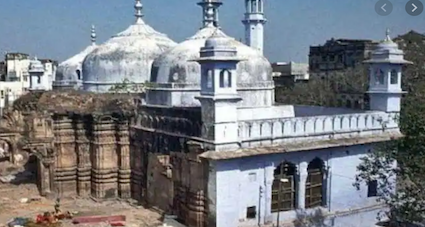It is such an illiterate piece by Swaminathan S. Anklesaria Aiyar in Times of India today. A pillar of India’s largest selling English daily, Aiyar is known to a generation of India’s readers and many a journalists of our times have worked with him, including yours’ truly.
Aiyar in his OpEd today says the lower courts in Uttar Pradesh allowing Archaeological Survey of India (ASI) to find out if Gyanvapi mosque was built on a Hindu temple; and a court in Mathura admitting a similar petition on Shahi Mosque threatens endless “communal battles” and a mockery of “Places of Worship Act 1991.”
When South Africa has a “Truth and Reconciliation Commission”, to examine the excess against Blacks during the apartheid regime, it’s not a racist position. When Australia admits “shame” of failing to help Aboriginals, it’s not to cause communal riots. When BlackLivesMatter takes the world by storm, it’s not to pit Blacks vs Whites. If the extermination of Red Indians is such a hot button in US academia, it’s not to ignite a civil war. Or why keep Holocaust memory alive at all?
All such measures were not to keep the wounds festering. It’s to acknowledge the terrible past. It’s to confess the terrible fate which millions suffered over generations. It’s to give respect to the dead. It’s to pay homage to memory of sufferers. It’s to look into eye of history and say: Yes, it was a monumental crime. And that we shall never let it happen again. Such acknowledgments don’t cause “communal riots”.
The Muslim invasion and rule over India, in the words of famous US historian Will Durant, was the bloodiest in human history. The indigenous population had to part with their women, land, resources—and existing beliefs and religion. For centuries, this nation and its people fought an existential fight. Hindus could’ve well gone the Red Indians way.
Aiyar then rakes up the “Places of Worship Act 1991.” As per this Act, he says, religious disputes after August 15, 1947, the day of independence in India, are not to be entertained. A status quo would be maintained. Only if there are lingering court cases before Independence, could it continue.
Now, Aiyar either doesn’t know or is indifferent, such caveats don’t apply on matters of archaeological studies. For such matters concern the nation’s cultural legacy. An archaeological studies and excavations could be carried out on issues of cultural importance. And that’s why the lower court in Varanasi has granted the permission to Archaeological Survey of India to do survey on Gyanvapi Mosque. And that’s why even the Supreme Court hasn’t dismissed the order; it has just stayed the matter for the time being.
The “communal battles” and “Places of Worship Act 1991” past, let’s look at Gyanvapi Mosque closely. And try to measure the Petition on its merit.
(An illustration by Shirisha Acharya: (Text in Bengali translated) “Long beneath Gyanvapi, seats Mahakal, unearthed, neglected”)
The Petition quotes “Skanda-Purana” and its chapter on Kashi (Varanasi) where there is mention that Hindus have been seeking “Nirvana” or “Moksha” (Salvation) in this Holy City for millenniums. As per Hindu holy scripture “Skanda Purana”, Lord Shiva asks his consort Goddess Parvati to provide food to everyone who lives in Kashi. And that anyone who dies here, would be blessed with salvation by him. Goddess Parvati then questions how could anyone attain salvation without “gyan” (knowledge). Lord Shiva then provides for a Gyan-koop (Knowledge-Well) at Vyas Peeth location in the holy city. A human being seeking salvation has to take a round of this city where 33- crore Hindu Gods are believed to be living. This exercise is called “Panch-kosi” Parikrama or circumambulation. It begins and ends at Gyan-koop. It’s believed that during their “agyatvaas” (period of banishment), the five Pandavas had done their circumambulation in Kashi, beginning and ending at Gyan-Koop. There is a Shivling in Shivpuri which falls on this circumambulation and which is said to have been established by the Pandavas.
This petition incidentally has been filed by none other than Vyas parivar which for generations has been facilitating this vow to Hindus who come to the Holy City, looking to do “Panch-Kosi Parikrama”.
Nobody expects that existing mosques in Varanasi or Mathura would be destroyed by these petitions. But ASI doing its survey and establishing an identity which is so fundamental to a billion Hindus isn’t communal. It’s to acknowledge the injustice and the centrality of Gyanvapi to the cultural memory and legacy of Hindus. Something which remains relevant to this day. We Hindus still go to Kashi to put ashes of our departed in the Ganges, flowing alongside the holy city. Muslim boards too should encourage, and not oppose such a survey. Hindus have been nursing this wound for centuries.
The rest of the Aiyar piece is similarly humbug. He mentions a few mosques which were converted into temples during the terrible days of the Partition; he mentions the past in which a Hindu ruler destroyed the temple of a conquered ruler; he cites global examples from Spain and Turkey which is nothing but whataboutery. I mean the Partition and Slavery-of-a-Millennium can’t be equated. At best, the Partition was a religious riot on a big scale. The two sides did what they could to hurt each other. Hindus were angry because India had also lost its land. The Hindu slavery to Muslim invaders, on the other hand, was a cultural and physical genocide. One was for a few weeks, the other for many a centuries. By picking up an example from the 7th century to show Hindu vs Hindu and temple destruction at best is loot and not religious imposition.


